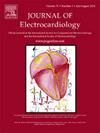不确定的冬季模式背后的心脏保护痕迹
IF 1.3
4区 医学
Q3 CARDIAC & CARDIOVASCULAR SYSTEMS
引用次数: 0
摘要
虽然de Winter综合征等同于STEMI,但ST段压低而非ST段抬高的原因尚不清楚。本研究旨在通过比较de Winter模式患者和典型前路STEMI患者的心电图和影像学表现,探讨de Winter模式的机制。方法本研究于2019年1月至2022年12月对967例诊断为前路心肌梗死的患者进行研究,其中30例诊断为de Winter模式,每例患者与4例前路STEMI组患者相匹配。两组患者行首次PCI治疗,观察其特征。结果约3%的前路心肌梗死患者表现为de Winter型。de Winter组中男性占67%,对照组中男性占62% (p值= 0.6)。多血管疾病在de Winter患者中更为普遍(60%比38%;p值= 0.03)。20%的de Winter病例和26%的AMI病例存在发育良好的抵押品(p值= 0.5)。两组间壁运动评分指数差异无统计学意义(1.9 de Winter vs. 1.97 AMI;p值= 0.3)。恶性心律失常(7% vs. 27%;p值= 0.01)和住院死亡率(3% vs. 18%;p值= 0.04)在de Winter患者中发生率较低。结论基于de Winter组非致死性缺血发生率更高的间接证据,以及这些患者预后较好,我们可以考虑预处理可能是de Winter心电图模式的潜在原因。本文章由计算机程序翻译,如有差异,请以英文原文为准。
Traces of cardioprotection behind the uncertainty of the de winter pattern
Introduction
Although de Winter syndrome is equivalent to STEMI, the cause of ST depression rather than ST elevation is still unknown. This study aimed to investigate the mechanisms underlying the de Winter pattern by comparing ECG and imaging findings between patients exhibiting this pattern and those with typical anterior STEMI.
Methods
This study was conducted from January 2019 to December 2022 on 967 patients diagnosed with anterior MI. 30 patients were diagnosed with the de Winter pattern, and each patient was matched with 4 patients in the anterior STEMI group. Patients underwent primary PCI, and their characteristics were examined in two groups.
Results
Approximately 3 % of patients with anterior MI showed a de Winter pattern. 67 % of the cases in the de Winter group and 62 % in the control group were male (P-value = 0.6). Multivessel disease was more prevalent in de Winter patients (60 % vs. 38 %; P-value = 0.03). Well-developed collaterals were present in 20 % of de Winter cases and 26 % of AMI (P-value = 0.5). There was no significant difference in the wall motion score index between the two groups(1.9 de Winter vs. 1.97 AMI; P-value = 0.3).Malignant arrhythmias (7 % vs. 27 %; P-value = 0.01) and in-hospital mortality (3 % vs. 18 %; P-value = 0.04) occurred less frequently in de Winter patients.
Conclusion
Based on the indirect evidence of the more extensive occurrence of non-lethal ischemia in the de Winter group, along with the better outcomes in these patients, we can consider preconditioning as a possible underlying cause of the de Winter ECG pattern.
求助全文
通过发布文献求助,成功后即可免费获取论文全文。
去求助
来源期刊

Journal of electrocardiology
医学-心血管系统
CiteScore
2.70
自引率
7.70%
发文量
152
审稿时长
38 days
期刊介绍:
The Journal of Electrocardiology is devoted exclusively to clinical and experimental studies of the electrical activities of the heart. It seeks to contribute significantly to the accuracy of diagnosis and prognosis and the effective treatment, prevention, or delay of heart disease. Editorial contents include electrocardiography, vectorcardiography, arrhythmias, membrane action potential, cardiac pacing, monitoring defibrillation, instrumentation, drug effects, and computer applications.
 求助内容:
求助内容: 应助结果提醒方式:
应助结果提醒方式:


